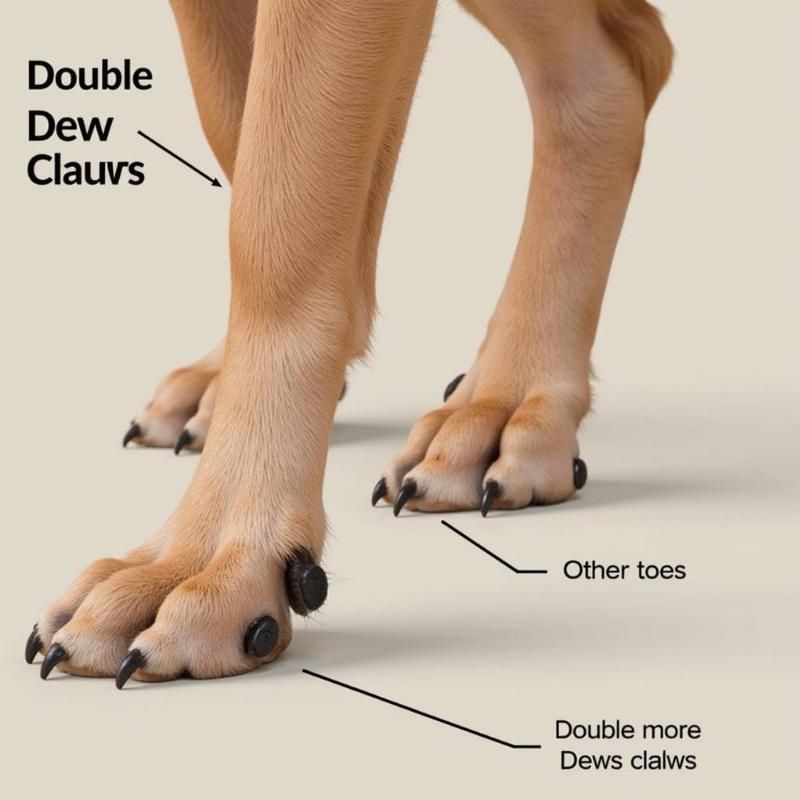Double dew claws, those extra digits located on a dog’s hind legs, often pique the curiosity of dog owners. While many breeds have front dew claws, hind dew claws are less common, adding a touch of distinction and raising questions about their purpose and care. Understanding which dog breeds possess this unique trait, its potential implications, and proper management is essential for responsible dog ownership.
Decoding the Double Dew Claw: Why Some Breeds Have Them
 Chó có móng lồi sau
Chó có móng lồi sau
So, what exactly are hind dew claws? These extra digits are essentially non-functional thumbs located higher up on the dog’s hind leg. Unlike the front dew claws, which offer some degree of stability during activities like digging or gripping, hind dew claws generally don’t touch the ground and serve no practical purpose in most breeds. Their presence is primarily attributed to genetics, often appearing in breeds whose ancestors were used for tasks requiring enhanced grip and maneuverability in challenging terrains. Think of breeds like the Great Pyrenees, used for traversing snowy mountains.
Common Dog Breeds Sporting Hind Dew Claws
Several dog breeds are known for their hind dew claws. These include the Beauceron, Briard, Great Pyrenees, Icelandic Sheepdog, Norwegian Lundehund, and Spanish Mastiff. While the standard for some of these breeds requires hind dew claws, for others it’s simply a common occurrence. Knowing if your breed is predisposed to this trait can help you prepare for their specific needs. For example, dog breeds with dew claws often benefit from specific grooming practices to prevent issues like ingrown nails.
A Closer Look at the Beauceron: Double Dew Claws and Herding Heritage
The Beauceron, a French herding breed, exemplifies the connection between hind dew claws and historical working roles. These dogs were bred to herd sheep over challenging terrain, and their double dew claws likely provided additional grip and balance. Today, while not essential for their everyday activities, double dew claws remain a defining characteristic of the Beauceron breed standard according to the American Kennel Club.
Caring for Hind Dew Claws: Essential Tips for Owners
Hind dew claws, because they don’t wear down naturally, require regular trimming to prevent overgrowth, infection, and potential injury. If left untended, the claw can curve back into the paw pad causing pain and discomfort. Regular grooming is crucial. Are you unsure about how to trim your dog’s dew claws safely? Consult with a veterinarian or professional groomer for guidance. They can demonstrate the correct technique and recommend the appropriate tools. You can also find resources online, including articles on what dog breeds have rear dewclaws, that provide helpful tips and visuals.
Conclusion: Embracing the Double Dew Claw
Double dew claws, while a relatively uncommon trait, are a fascinating part of canine anatomy. Understanding their origin, recognizing the breeds that possess them, and implementing proper care ensures the health and well-being of our furry companions. By staying informed and proactive, we can celebrate this unique characteristic and provide the best possible care for dogs with hind dew claws.
FAQ
-
Do all dogs with front dew claws also have hind dew claws? No, front dew claws are more common than hind dew claws. A dog can have front dew claws without having hind dew claws, and vice-versa.
-
Can hind dew claws be removed? While dew claw removal is sometimes performed, especially on the front legs, it is generally recommended to leave hind dew claws intact unless there’s a medical reason for removal. Discuss this with your veterinarian.
-
Are hind dew claws painful? Hind dew claws are not inherently painful. However, if they become overgrown or infected, they can cause significant discomfort.
-
How often should I trim my dog’s hind dew claws? Trimming frequency depends on the individual dog and how quickly their nails grow. Generally, checking them monthly and trimming as needed is a good practice.
-
What are the signs of an infected dew claw? Signs of infection include redness, swelling, discharge, and lameness. Contact your veterinarian if you notice any of these signs.
-
Are there any specific health issues associated with hind dew claws? While generally not a problem, hind dew claws can sometimes get caught or injured, leading to tearing or infection.
-
My dog’s breed standard requires double dew claws, but my puppy only has single dew claws. Is this a problem? Yes, this deviation from the breed standard might be an issue in show dogs. Consult with a breed expert for further guidance.
Related Articles
- What breeds of dogs have rear dewclaws
- Small dog breeds with back dew claws
- Dog breeds double dew claws
Beautdogs.us is your trusted online resource for comprehensive dog care information, breed insights, and a curated selection of products catering to the specific needs of dog owners in the United States. Whether you’re a seasoned dog parent or welcoming your first furry friend, Beautdogs.us offers expert guidance and reliable resources to ensure your canine companion thrives. Contact us at [email protected] or call +1 501-555-7529 for personalized support. Visit Beautdogs.us today to embark on a journey of happy and healthy dog ownership!